Notes by Aaron from September 12th and 13th Iowa workshop:
Drills:
stepping foundation drills: power is constant, speed determines the appearance of more force.
Positive circles, negative circles, mixed circles, 6 sealing 4 closing
long stepping drills (length of room, and then back several times):
initial step out from first move (emphasis on finding a resting spot in the middle
red fist (double positive circles) – no link to the body from the hands (desynchronized)
syncopated, with multiple layers of syncopation (at least 3, top, middle, and bottom)
Jade lady – right hand linked to right foot, move occurs in 3 parts (time-wise) lock in a straight line in the air (can unlock before landing)
Kick left with both fists – set up structure, then explode out, then implode in
Same with right side,
Erlu form (cannon fist) with explosive power
All cannon fists are back-fists.
Every move is like climbing a tree
Always almost about to fall
There are links / connections in a person
The connection / link of the arm is the elbow
The link of the body is the waist
The link of the legs is the knee
For the jump in Jin Gong, the waist link is required
single leg jump while maintaining the waist connection to practice
Move like a monkey, with the waist
Not like an ape with the chest
Fight like there’s a screwdriver in your hand.
Stab it in, then rotate
Remember, cannon fist is for maiming.
The explosive power needs to be focused rather than dispersed.
Train until the body becomes native (like learning a language)
Have to explode with not residual energy
Drive the power through the opponent
Learning can be like heating water.
If you need hot water, and don’t wait for it to boil (just wait until it’s hot), you won’t find out that boiling water can bubble.
You need to keep it on the heat, and watch it for a while in order for it to boil; and for you to see the bubbles.
Once you see the bubbles, you can start wondering what’s different.
You have to put in the time in order to see the bubbles and start wondering.
Watch the form (in person or recorded) for 4 months in order to start seeing the details, rather than assuming that what you see is what’s actually occurring.
We don’t see what Master Chen is doing, we see what we think he’s doing. We don’t hear what he’s actually saying, but what we think he’s saying. Our filters are interfering with learning.
The chair, or glasses we see in our heads is interfering with the one he’s trying to show us.
The movement we expect to see is interfering with the movement he’s showing us.
This is why watching the form for ~4 months is important. So we can see what’s actually being done, rather than what we expect, assume, or filter out.
Specific note: If you understand something, you can do it.
If you can’t do it, you don’t understand it.
Recalibrate expectations to this. If you’re asked if you understand, and you can’t do it; you didn’t understand.
Did you see it?
Did you hear it?
Did you write it down?
Can you do it?
If not, then you don’t understand it.
Deviations are due to misunderstanding.
Thought exercise; How many #1 are there? 1.
How many #2? 1. (Though it is made up of 2 1s)
Train as if you have an opponent. When fighting remember the form and finish the moves.
Don’t change the form for your opponent.
You wouldn’t re-sharpen an already honed blade to cut a melon.
Be strong, but don’t use power.
Grandmaster Hong said that every move must be exaggerated by a factor of 10 when used.
There was a question on what the opponent might do after a given move succeeds.
Many things, from a hospital or grave.
Cannon fist is to maim.
This question can be a useful one for investigating taiji technique.
If you have this question, practice until you don’t have it anymore.
Move detail;
Chop wood from the bottom, the secret is to get small (and low) beforehand.
Place the foot at the hollow of the knee before this move.
Push hands:
Always find catch 2 contacts with the hands. Never just slap hands.
The foot must find the knee (or foot) for the third point.
Pivot from the 3rd point.
Canon fist is a reversal from yilu
Rotate the center to drive outside rotations
rather than rotating the outside to drive the center
The word used for the jump in fist wrapping the body is that of a pheasant flying (low and close to the ground)
Aim the back knee at the opponent’s groin.
Practice length of training area jumps, be stable, don’t protrude, don’t indent.
Exercise: Pendulum leg, lift one leg high to the side, bring it down like a pendulum, and switch at the center (kicking the other foot) transfer all the energy. Step down with foot in air, and repeat. Continue the length of a training area.
Taiji movements must be like this (light, no shifts in height or lifting)
Taiji dance:
Fun dance, using white crane. All about throwing, setting up, getting in, timing
Get in, get behind, get low, go long.
can do without getting opponent’s balance (by going between their legs), doing so without that involves wrapping their upper body.
Get past the strike, totally avoiding it, don’t leave an arm in.
Once past then the hand comes back, and leg gets in. If the hand lingers, they can defend against it.
Changing the pivot:
The opponent can only push on what’s in front of them.
Get something past them, they can’t push on it.
Get a knee in past them, lock it and anchor to it.
Pivot from that point, adjusting the back leg further back as needed.
Power should be at 90 degrees to the opponent’s structure.
Discipleship ceremony for Chris Dusek and Jeff Clevenger
Hand that’s not doing positive circles should be on chest during single cloud hands.
Don’t retreat
Change reference point, don’t retreat from that reference point. Always advance.
The reference point can change during moves.
Example: 6 ealing, four closing. Torso advances towards the hand, rather than the hand retreating back to the torso.
Never withdraw the hand.
create separation along a line that the opponent is also on. Remove the other from that line.
example, in positive circle, when the opponent is on the line from the back foot, rotate the front hand (positive circle)
Sleight of body
don’t move the center,
take out all the space while rotating in (wedging in) towards the opponent.
Doesn’t give the opponent any clues
Don’t move is shorthand using a series of discrete non-moving rotations, pivoting around the axis of each change.
Hand-swinging exercise
Shake hands, and swing them gently.
When pulling, you can focus the pull by pointing a finger.
if a larger change is needed, then make the lever larger (use circle)
Keeping on the center:
connect to the center
move the kua in to touch the opponent
create a rotation that their structure can’t handle.
Rotate from the center, not from the contact point (use the door handle, not the hinge)
Don’t lift.
Left cannon fist / right cannon fist exercise:
No retreating at the waist.
Hit is like scooping.
Jump, anchor, pull
Repeat drill both sides, 100 times.
back hand holds
front hand grindes, pulling opponent directly into you.
They will only fear the pull if it’s towards you. If you’re pulling to the side, or out into space, they won’t fear it.
Create a speed differential both in each arm, and between each arm.
There should be a difference between each hand and elbow. Same thing happens in 6 sealing 4 closing.
There are 4 gears, each at a different speed (each hand and each elbow)
Different application, the elbow starts a momentum to make the other crash in , such that your hand hits their throat.
private lesson:
Overall instructions:
Move less, rotate more
Maintain body connections
Separate moves more: I tend to combine movements of shoulder with movements of kua; keep them distinct.
On this same step, make the step without moving to the side. Finish the step, then adjust the body (without changing any part of it)
An example of this is the step following Jin Gong pounds the mortar.
On single whip, the instruction is to step directly into the opponent from the fist, rather than angle, or turn partially.
Arm angles were adjusted to be more angled. The chest needs to become concave.
On white crane spreads its wings, the top hand needed to be higher, and the bottom hand lower
Additional instructions included:
connecting the waist into the legs, expanding and filling that space
Making the lever longer: While maintaining a hold on the opponent’s shoulder (and without changing it whatsoever), drop the body and lengthen the back leg (making my lever on the opponent significantly longer).
In a similar way, a move can be masked by focusing the opponent’s attention elsewhere. Then changing a part of the structure (e.g. making the lever longer, realigning the arm).
Focusing arm and fingers directly on the opponent; there’s a spot and line that will prevent the opponent from coming in, elbow in while doing hand out along that line will help with correct alignment. Small and subtle realignments.
During the afternoon Master Chen taught an exercise on how to go in when the opponent is strong on top. This involves a lot of pratice, and falling down (toe pointing forward and being swung in when opponent pushed on top). This led to an exercise involving hopping with one leg forward (and off the ground); the supporting leg attempting to kick the bottom of the kicker before coming back down as a support.
Hand out, elbow in was a focus; the idea is to align the hand, keep the bones in the same place, and rotate the skin and flesh around the bones. The exercise given with this was to grab the skin and flesh below the elbow, and rotate it towards the outside (spiraling down towards the elbow).
—
Notes by Kelvin
– Keeping the back straight at all times
– Always have an aim at the centre, every movement should result back to the centre (don’t deviate from it)
– Keep the movement small, otherwise it is wasteful
-Separation: When the hands have power, move in the waist. Have power in the waist, the hands can become free. Nudge in bit by bit

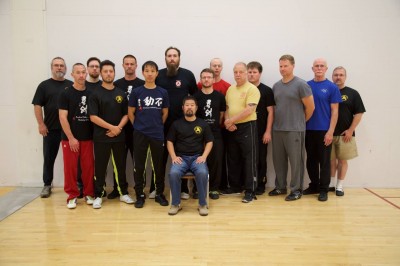
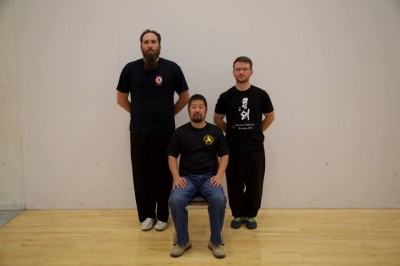
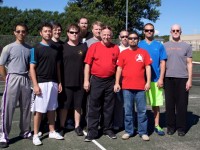
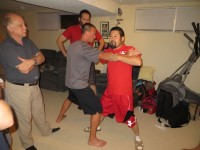
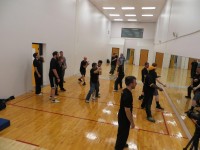

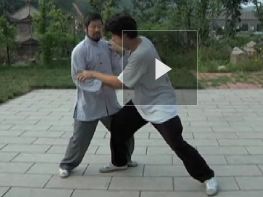
{ 2 comments… read them below or add one }
This was a phenomenal workshop! The depth and clarity of Master Chen’s instructions allowed me to understand and physically demonstrate taiji methods and principals that are deep and complex. Many of my disciple brothers (10 disciples in all) and serious Practical Method students attended. The cohesion of the group lead to non stop learning and training. Every morning people were up by 4:15 am doing yilus and erlus. We frequented the local park for private lessons with Master Chen, which during those not receiving individual instruction pushed hands and trained. The main portion of the workshop focused on Erlu (Cannon Fist). The entire 2 days was a brutal pace, even during breaks we trained, pushed hands and worked on applications. I gained much, and now it is up to me to keep what has been transmitted from Shifu, practice the things I learned, and address the corrections I was given. It was everything I wanted from this event and then mush more…pure awesomeness!!! A big thanks to Master Chen and all that attended!
I’ll be looking forward to the videos from this workshop, I regret not being able to attend.